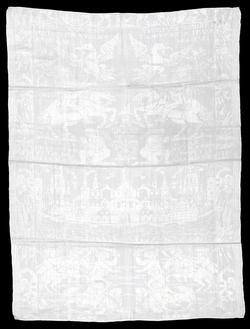Current Location: In storage
Maker(s)
Production:
Unknown
Entities
Categories
Description
Damask napkin with an outer chequered border (on two sides only) and an inner border consisting of the Eagle of the Empire.
The central napkin motif contains a symmetrical pattern of six horizontal bands, each containing two repeats of the different patterns. 1-the lower portion of a coat of arms. 2- an eagle with a crescent moon in its beak and the inscription 'Viribvs evgeny aqvila devorat lunam' 3- a horseman. 4- a man with his hands chained kneeling with the inscription "Turca precatur vitam". 5- a city (possibly Belgrade) 6- a battle scene
The napkin commemorates the defeat of the Turks in Belgrade in 1717. 'Evgeny', or Eugene of Savoy in the spring of 1716 was appointed to command the army of Hungary; and at Peterwardein he gained (5th of August 1716) a signal victory over a Turkish army of more than twice his own strength. In recognition of this service to Christendom the pope sent to the victorious general the hat and sword which the court of Rome was accustomed to bestow upon those who had triumphed over the infidels. Eugene won another victory in this campaign at Temesvr. But the ensuing campaign, that of 1717, was still more remarkable on account of the battle of Belgrade. After having besieged the city for a month Eugene found himself in a most critical, if not hopeless situation. He had to deal not only with the garrison of 30,000 men, but with a relieving army of 200,000, and his own force was only about 40,000 strong. In these circumstances the only possible deliverance was by a bold and decided stroke. Accordingly on the morning of the 16th of August 1717 Prince Eugene ordered a general attack, which resulted in the total defeat of the enemy with an enormous loss, and in the capitulation of the city six days afterwards
Legal notes
Given by the Marchioness of Bristol
Measurements and weight
Length: 28.3/8 in
Width: 37.7/8 in
Acquisition and important dates
Method of acquisition: Given
(1943-01-15)
by
Marchioness of Bristol
Dating
18th Century, first half
Circa
1717
CE
-
Circa
1750
CE
Note
The first Latin inscription, deliberately changes Eugene to Evgeny, to retain regularity in the dactylic hexameter of the epic meter utilised.
People, subjects and objects depicted
Materials used in production
probably
Linen
Techniques used in production
Weaving
: Damask
Inscription or legends present
- Text: Viribvs evgeny aqvila devorat lunam
- Location: Horizontal band on the central motif of the napkin
- Method of creation: Woven
- Text: Turca precatur vitam
- Location: Horizontal band on the central motif of the napkin
- Method of creation: Woven
Identification numbers
Accession number: T.1-1943
Primary reference Number: 110476
Stable URI
Audit data
Created: Saturday 6 August 2011
Updated: Thursday 22 May 2025
Last processed: Thursday 22 May 2025
Associated departments & institutions
Owner or interested party:
The Fitzwilliam Museum
Associated department:
Applied Arts

 IIIF Manifest
IIIF Manifest




